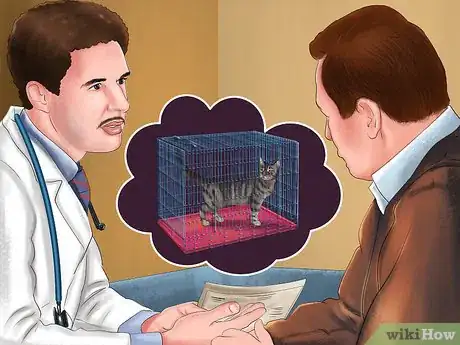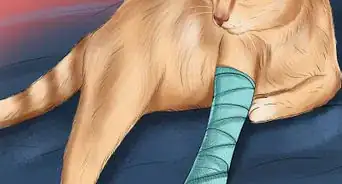This article was co-authored by Melissa Nelson, DVM, PhD. Dr. Nelson is a Veterinarian who specializes in Companion and Large Animal Medicine in Minnesota, where she has over 18 years of experience as a veterinarian in a rural clinic. She received her Doctor of Veterinary Medicine from the University of Minnesota in 1998.
This article has been viewed 10,374 times.
Dislocated hips are uncommon, but can afflict aging cats. If this is the case, your cat will need a surgery to realign the hip joint properly. If your cat has undergone a surgery to correct its dislocated hip, it will need your help around its living space to recover fully. Primarily, you’ll need to keep your cat on “cage rest” (securely in its cage or kennel) or confined in a single room for three to four weeks. Make sure the cat receives any prescribed medication, and that it has easy access to food and water.
Steps
Bringing Your Cat Home from Surgery
-
1Give your cat vet-recommended amounts of food and water. After the surgery, your cat will probably have very little appetite, and may not want any food for a day or two. Follow your veterinarian’s advice on how much to feed your cat following the surgery, and make sure your cat has access to clean water.
- Providing your cat with too much food and water after surgery will make it nauseous, and it may vomit.
-
2Prevent your cat from licking or grooming the stitches. Your cat may try to claw or bite at the sutures following surgery. If the cat continually tries to scratch or groom the injured hip, ask your vet for a large plastic cone to place around your cat’s neck, so it cannot bite or lick at the sutured area.[1]Advertisement
-
3Give your cat a restful environment. Your cat will be groggy and tired after the surgery, and may not return to a typical energy level for days. During the time they’re healing, your cat will need a solitary, quiet place to recover. Also give the cat soft, comfortable bedding to sleep and rest on. If your cat is on cage rest, you can place soft towels or bedding in the kennel.[2]
- It’s very important to keep your cat from jumping after surgery, so ensure there isn’t furniture or other items your cat may be tempted to jump on in their environment.
- If you have other animals or small children in the household, keep them away from the cat, as they will likely bother and stress the cat.
Keeping the Cat Confined
-
1Follow your surgeon’s guidance on the cat’s confinement. Due to the sensitive nature of the operation, your vet will likely recommend that the cat be confined following the surgery. In mild cases, the vet may suggest confinement to a single room in your house. However, if the vet is concerned that the hip may dislocate again, they may request that you confine your cat to a single large cage or kennel.[3]
- In most cases, your vet will request that you bring the cat in for a follow-up inspection a month or two after the surgery.
-
2Do not allow the cat out of its cage. It’s important that, while the cat recovers from its hip dislocation surgery, it be confined in a large cage or pet kennel. Although the cat will doubtlessly protest its restricted movement, it’s for the cat’s own good. If the cat is allowed into too large of an area, it may run or jump, and re-dislocate the hip that was just operated upon.[4]
- In cases where the vet suggests milder confinement, keep the cat shut in a room, such as your bedroom, laundry room, or small basement.
- If possible, remove from the room low pieces of furniture (desks, chairs, dressers, etc.) that the cat could jump up onto, so it doesn’t injure itself in the process.
-
3Feed your cat in the kennel. Since your cat will be confined for three to four weeks, you’ll need to work out a system for feeding it within its large cage. If you visit your local pet store, you’ll find various models of food and water bowls which attach directly to the wire mesh of the kennel door. Using a door-mounted type of bowl, provide your cat with frequent access to food and constant access to water.
- Attaching food and water bowls to the door itself will keep the floor of the kennel cleaner, since your cat won’t be able to knock its food and water down onto the bottom of the kennel (and whatever blankets and pads it may have).
-
4Give your cat access to a litter box. Whether your cat is confined to a large kennel or to a single room, it will need to have frequent access to a litter box. If you cat is on cage rest, release the animal into a small room (such as a bathroom) which contains the litter box. Let the cat do its business, and then return it to the cage.
- This will be easier to provide if your cat is confined to a single room. Simply lay down a sheet of plastic on the ground, and then place the litter box on top of that.
Caring for Your Cat at Home
-
1Give your cat any prescribed medications. Your veterinarian will doubtlessly send you home with various prescribed medications: likely one or two painkillers to keep your cat from suffering, and an antibiotic to prevent infection. Follow the vet’s directions and the directions written on the packaging concerning how many pills you should give your cat, and how often they should be administered.[5]
- If you run out of a certain medication but feel that your cat would benefit from more (e.g. a painkiller), contact the vet’s office about a refill.
-
2Watch for signs of bleeding or lingering redness. It’s normal for your cat’s skin surrounding its sutures to be reddened (and even bleed lightly) for the first couple of days following the surgery. However, if the area stays red for longer than two or three days, or if you see a scab forming by the sutures, you should contact your veterinarian. Also contact your vet if you notice any other concerning symptoms in the area operated on, including:[6]
- Swelling or bruising
- Fluid discharge or an unpleasant odor
-
3Give your cat attention. Your cat may be anxious or upset following the surgery. Especially if your cat is sequestered, make sure to spend time with it. Pet or stroke your cat and speak to it in a soothing voice. Spend time in the room your cat is in, even if they are in a cage. This will help your cat feel less anxious and more comfortable.
-
4Take the cat to the vet for a follow-up surgery. If your cat had any pins installed in its hip (in order to help the hip heal correctly) during the hip displacement surgery, you will need to schedule a follow-up appointment. During this appointment, the vet will surgically remove the pins. Plan to have the follow-up appointment and surgery three or four weeks after the initial surgery.[7]
- If the cat’s hip did not have pins inserted, there may be no need for a follow-up appointment.
- As always, check with your veterinarian to see if they recommend a follow-up.
References
- ↑ https://www.petcarerx.com/article/caring-for-your-cat-after-surgery/831
- ↑ http://consciouscat.net/2010/11/29/caring-for-your-cat-after-surgery/
- ↑ https://vcahospitals.com/know-your-pet/hip-dislocation-and-post-op-care-in-cats
- ↑ https://vcahospitals.com/know-your-pet/hip-dislocation-and-post-op-care-in-cats
- ↑ https://vcahospitals.com/know-your-pet/hip-dislocation-and-post-op-care-in-cats
- ↑ https://www.petcarerx.com/article/caring-for-your-cat-after-surgery/831
- ↑ https://vcahospitals.com/know-your-pet/hip-dislocation-and-post-op-care-in-cats
About This Article
You can help your cat recover from hip dislocation surgery by setting out soft, comfortable bedding for it to sleep on. Additionally, if your vet recommends it, you should keep your cat confined to its cage or a single room to prevent it from jumping and hurting itself again. Make sure to keep your cat’s food, water, and litter box nearby so it has access to everything it needs to keep healthy. Aside from the necessities, your cat will also need some attention to feel better, so take time to pet it and talk to it in a soothing voice. To learn how to recognize signs of infection on your cat’s sutures, read more from our Veterinary co-author.




































































